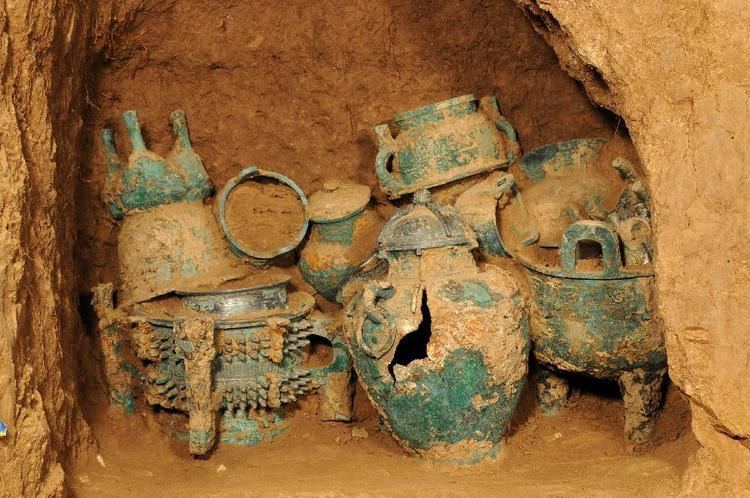Area 18,712 km2 | ||
 | ||
Map of Baoji
Baoji (simplified Chinese: 宝鸡; traditional Chinese: 寶雞; pinyin: Bǎojī) is a prefecture-level city in western Shaanxi province, People's Republic of China.
Contents
- Map of Baoji
- Baoji bronze ware museum
- China street food in kunming
- Geography
- History
- Ancient trackways
- Industrial Zone
- Military
- References

Baoji bronze ware museum
China street food in kunming
Geography

The prefecture-level city of Baoji has a population of 3,716,731 according to the 2010 Chinese census, inhabiting an area of 18,172 km2 (7,016 sq mi). The city itself has a population of approximately 800,000. Surrounded on three sides by hills, Baoji is in a valley opening out to the east. Its location is strategic, controlling a pass on the Qin Mountains between the Wei River valley and the Jialing River. Passing through Baoji is the ancient Northern Silk Road, the northernmost route of about 2,600 kilometres (1,616 miles) in length, which connected the ancient Chinese capital of Xi'an to the West over the Wushao Ling Mountain to Wuwei and emerging in Kashgar before linking to ancient Parthia.
History

Thriving early in the Tang dynasty, it has roots to 2000 BC. Today it is a large industrial center. Railways first reached Baoji in 1937 and have been key to its modern growth.
Baoji is considered the gateway between western and eastern China since most trains from Beijing, Shanghai and Xi'an pass through here on their way to Gansu, Sichuan, Xinjiang and Tibet (Lhasa). Fa Men Si (Famen temple), home to one of Buddha's finger bones, is in Baoji County. The Baoji area was home to the legendary Yandi, one of the Han Chinese forefathers. His tomb is in the southern part of the city and his temple is in the north.
People who are interested in the Three Kingdoms of ancient China can visit Zhuge Liang's Memorial Temple, about 20 km (12 mi) from Baoji. (To get to the temple, take the bus from Baoji XinJianLu Bus Terminal to Gaodian, then transfer to taxi. Taxi fare to the temple from Gaodian is about 20-30 renminbi varying by season.)
Ancient trackways
Mount Taibai still has some remaining traces of roadways built during the Three Kingdoms Period (220−280 CE) which are all generally unusable due to decay. They remain a popular attraction because they were built by making wood plank bridges along the side of the mountain.
To the South of Baoji lies the beginning of the plank road into the Qin Mountains. There are also several natural sites such as the Jialing Jiang Fountainhead with its small waterfalls and forests. To the north is Bei Puo, a giant hill made of loess with a panoramic view of the city and a landscape dotted with small farming villages that offer local cuisine.
A number of Longshan archaeological sites have been found north of the Wei River near the North Silk Road.
Industrial Zone
Established in 1992, Baoji Hi-Tech Industrial Development Zone was approved as a national hi-tech zone by State Council. It has a long-term planned area of 40 square kilometres (15 sq mi). The transportation system around the zone includes Xi'an-Xianyang International Airport and National Highway 310. Its encouraged industries are auto parts, electronics, IT, pharmaceutical and bioengineering industry and new materials.
Military
Baoji is the headquarters of the 21st Group Army of the People's Liberation Army, one of the two group armies that comprise the Lanzhou Military Region responsible for defending China's northwest borders.
